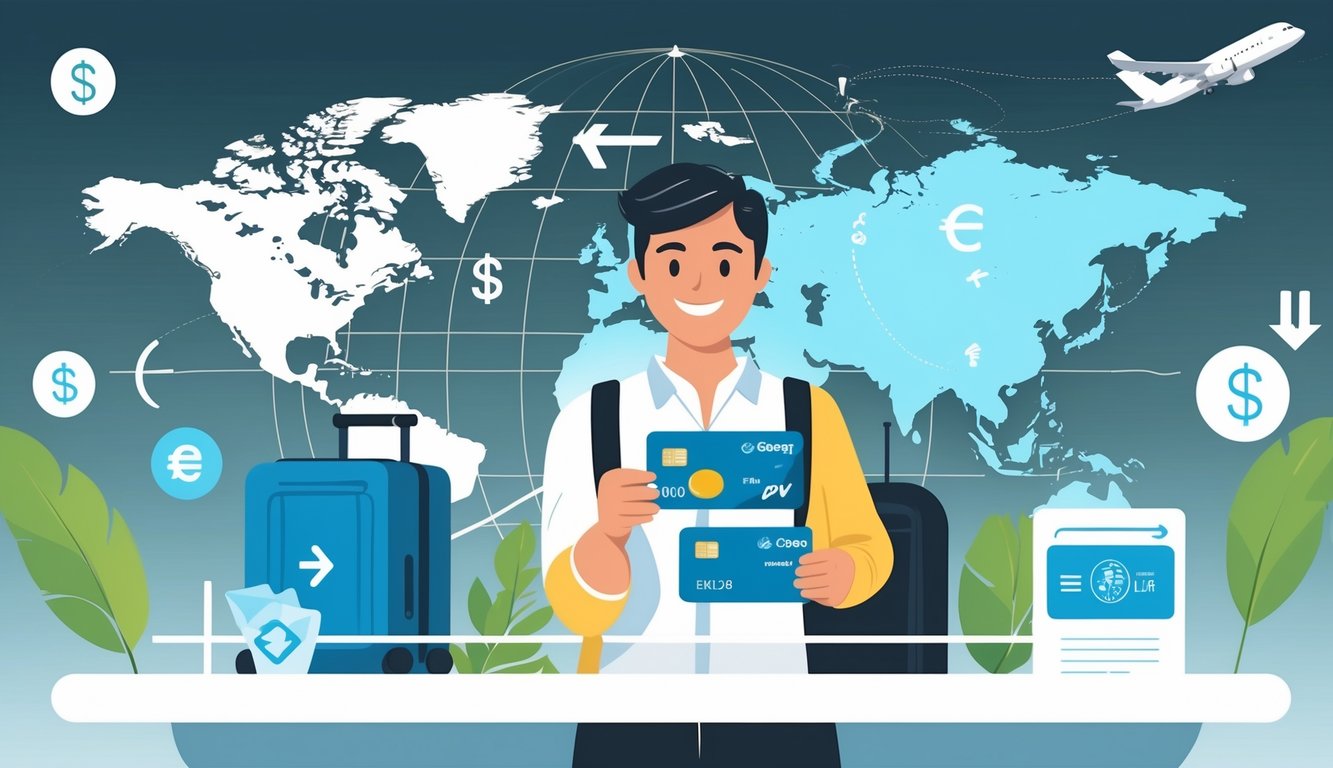
Tapping Into Travel Perks and Loyalty Programs

Ever try to get travel perks without a credit card? Feels like asking for a window seat and getting the middle. Loyalty programs are just puzzles—points everywhere, and the math never adds up how you expect. But, wow, credit cards can bulldoze international fees and drop random comforts right when you least expect it.
Airport Lounge Access and Elite Travel Benefits
Dragging myself through security, I always envy the people gliding into lounges. AmEx Platinum, Chase Sapphire Reserve—wave a card, and suddenly you’re inside with real coffee, Wi-Fi, maybe even a shower (yes, I’ve showered at an airport, don’t judge). The fine print never makes it clear, but a lot of premium cards bundle Priority Pass. Nobody cares if you look like you slept on the floor.
Elite perks? Early boarding sounds dumb until you see the gate agent shut the door. Delta SkyMiles Reserve throws you medallion boosts and Sky Club discounts. Even mid-tier cards sometimes have Mastercard concierge, but honestly, the best part is skipping the sad $12 sandwich and getting lounge food. Everyone complains about Centurion Lounge crowds, but if I get a chef-made omelet instead of a stale wrap, I’ll wait in line. Some cards toss in travel credits for bags or TSA PreCheck—just don’t forget to activate them, like I did last December.
Hotel Co-Branded Card Advantages
I checked into a Hilton on a Thursday—nothing special, just a work trip—and suddenly got bumped up to a suite. No idea why. Oh wait, that Hilton Honors Surpass card. Never in my life have I gotten a fruit basket at home, but hotels? Suddenly it’s “complimentary breakfast” this, “late checkout” that, and some weird sense of being important for five minutes. I’m not saying I love spreadsheets, but tracking points from direct bookings plus the bonus from co-branded cards is…well, it’s a hobby now, I guess. (Am I proud? Unclear.)
Once, my Marriott Bonvoy Boundless card dangled a free night and I blew it on an airport Sheraton. Still mad about it. These cards crank up the points—base rate’s maybe 10x per dollar on hotel stays, then the card throws in another 6x or so. But the perks? Not always as shiny as they sound. Hyatt, for example, loves to hide the good stuff behind brand walls. Reading the fine print is a drag but skipping it means you’ll miss out or just get quietly fleeced. Luggage allowance? Still stingy. But breakfast tastes better when you’re not paying for it, I swear.
Maximizing Airline and Hotel Loyalty Programs
Honestly, chasing status is like collecting state quarters—pointless, but also, I can’t stop. I figured out (after way too many mistakes) that not all points are worth the same. Everyone online says “transferable currencies are king,” and with something like Chase Sapphire Preferred, you can toss points over to United or Hyatt or whatever. But then—bam—blackout dates. I’ve had plans nuked by those more than once.
Racking up status miles is its own game. Amex Delta SkyMiles, British Airways Visa Signature—hit the minimum spend, get the fast track stuff. My friend burned 70,000 Avios for a flight worth $1,800, then bragged about “only paying taxes and fees.” Newsletters act like every loyalty program is gold, but they never mention the sneaky sweet spots, like using Alaska miles to book Cathay Pacific (best hack, honestly). Also, boutique hotels on off-peak nights? Hidden gold. I’ve spent hours spreadsheeting Marriott redemptions just to prove Tokyo Ritz is a better deal than LA, but people still blow double the points in Anaheim. Why? No clue.
Essential Rules and Requirements for Smart Travelers
No one warned me that following the “rules” would feel like a minefield. Miss a step and suddenly you’re hit with international fees or a credit denial at the worst possible time. I’ve had banks auto-deny me without so much as a courtesy email. It’s a circus.
Understanding and Navigating the 5/24 Rule
Nothing makes me want to flip a table like the Chase 5/24 rule. You happily apply, then—no warning—denied because you opened five cards in two years. No alert, just “denied.” Chase, Barclays, the rest—they all dig through your history like it’s Black Friday. So now I keep a spreadsheet: dates, approvals, the whole sad saga.
Even people with 800+ credit scores get tripped up. “Good credit means approval,” right? Nope. 5/24 doesn’t care. Amex sometimes ignores it, which is…why? Who knows. Banks make up the rules as they go. If you’re new, always go for the Chase cards first, or you’ll miss the big bonuses forever. I read on FlyerTalk about someone losing $1,500 in points because they didn’t know the sequence. Brutal.
Credit Score Considerations and Approvals
Credit score myths are everywhere. Some blog says “700+ is a lock,” but for cards like Chase Sapphire Preferred or Capital One Venture X, banks look at everything—utilization, hard pulls, average account age. I saw an Experian survey where 38% got denied for “inconsistent income reporting,” not scores. Is anyone even aware banks compare income to spend? My buddy, 760 score, got shot down for “too many recent inquiries.” He’d just paid off a car loan and thought it would help. Nope.
Amex and Citi sometimes use soft pulls for pre-approvals. Others go straight for a hard pull, and if you forgot to freeze a bureau, you’re out of luck. Once, I got approved for a card three weeks after I’d forgotten I even applied. Oh, and if you’re an authorized user on someone else’s card? Some banks count that against you, so my partner “helped” me get denied without realizing it. Credit Karma tries to predict approvals, but honestly, banks change the rules whenever they feel like it.
Optimizing Travel Benefits With Credit Card Points
Collecting points isn’t just about buying coffee and hoping for a miracle upgrade. Suddenly you’re eyeing business class, skipping security lines, or getting fast-tracked through immigration. The points-obsessed crowd (hi, Flyertalk) will tell you you’re wasting money if you don’t play the game. Even my accountant chimed in once about “using points wrong.” Thanks, I guess?
Strategic Booking for Maximum Value
One night, I had five browser tabs open, sweating over whether Chase Ultimate Rewards or Amex Membership Rewards would get me a better deal. Spoiler: not all points are equal, Reddit is wrong, and Chase points are worth 1.25¢ each on their portal, but if you transfer to United or ANA, they can jump to 2¢ or more (sometimes). Of course, I figured that out only after blowing double the points on a flight because I missed a hidden partner deal.
Booking with points is all timing and geography. Ignore co-branded cards like Marriott Bonvoy or Hyatt and you’re missing out if you ever drink hotel coffee at 6am (trust me). I once did a two-week Europe trip with points but forgot to use a single lounge pass. Check award charts, be flexible, and always compare transfer partners—twice. It’s a pain, but paying $86 in taxes for a $2,200 flight? Still wild. TPG says most people only use about 60% of their points efficiently, which feels about right.
Using Points for Global Entry and TSA PreCheck
Global Entry costs $100, and people act like it’s a big deal—until you realize most premium cards (Chase Sapphire Reserve, Amex Platinum, Citi Prestige) cover it. First time I used Global Entry, I breezed through customs and still got lost finding baggage claim. I’ve watched people stand in line forever while I flashed my PreCheck sticker like it was VIP access.
Most cards give you the rebate every four years, and you can use it for family or that cousin who always forgets their ID. The application used to be a pain—background checks, interviews—but after cards started covering the fee, enrollments jumped. DHS said it was a 20% spike. You’d think more people would know, but apparently, standing in line is a lifestyle.
Put a sticky note on your card, because I’ve paid for Global Entry twice by accident and only got reimbursed once. Use the right card, double-check the fine print. Airlines never mention this, but travel podcasts like Point Me to First Class will—if you’re into that sort of thing.



